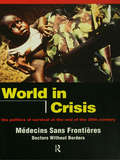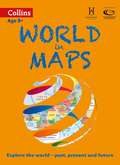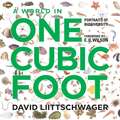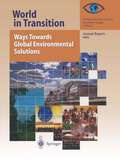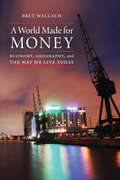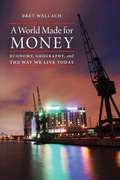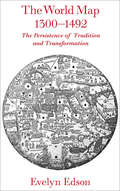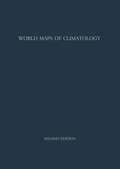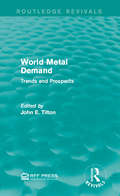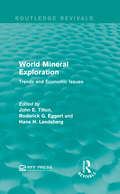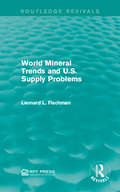- Table View
- List View
World in Crisis: Populations in Danger at the End of the 20th Century
by Médicins Sans Frontières/Doctors Without BordersThe tragedies of war, famine, disease and poverty continue to dominate our headlines. Faced with such tragedy, the politics, ethics, even the economics of humanitarian aid are becoming more complex. The role of relief agencies, the political will of the West, the reponsibilities of the international community for war crimes and human rights - these are all issues at the heart of contemporary humanitarian aid.World in Crisis - describing the plight of refugees and civilians caught up in war zones in both First and Third Worlds, the homeless, Gypsies, and AIDS/HIV groups in Europe and North America - highlights what can be done to alleviate human suffering in the future. The book concludes with reports from the frontline of the world's main conflict zones, in Bosnia, Liberia/Sierra Leone, Chechnya, Rwanda/Burundi and Sudan.Medecins Sans Frontieres/Doctors Without Borders is the world's largest independent organization for emergency medical aid. Through 25 years of action, the organization has become famous for bringing swift and direct aid to peoples affected by war and natural disaster, regardless of government consent.
World in Crisis: Populations in Danger at the End of the 20th Century
by Médicins Sans Frontières/Doctors Without BordersThe tragedies of war, famine, disease and poverty continue to dominate our headlines. Faced with such tragedy, the politics, ethics, even the economics of humanitarian aid are becoming more complex. The role of relief agencies, the political will of the West, the reponsibilities of the international community for war crimes and human rights - these are all issues at the heart of contemporary humanitarian aid.World in Crisis - describing the plight of refugees and civilians caught up in war zones in both First and Third Worlds, the homeless, Gypsies, and AIDS/HIV groups in Europe and North America - highlights what can be done to alleviate human suffering in the future. The book concludes with reports from the frontline of the world's main conflict zones, in Bosnia, Liberia/Sierra Leone, Chechnya, Rwanda/Burundi and Sudan.Medecins Sans Frontieres/Doctors Without Borders is the world's largest independent organization for emergency medical aid. Through 25 years of action, the organization has become famous for bringing swift and direct aid to peoples affected by war and natural disaster, regardless of government consent.
World In Maps (Collins Primary Atlases Series (PDF))
by Stephen ScoffhamCollins World in Maps is a multi-topic atlas of the world, which introduces the most relevant physical and human topics to reflect the Geography Key Stage 2-3 requirements of the National Curriculum. Formerly published as Collins Keystart World Atlas, this collection of maps can be used to investigate different themes and topics. It tells a story in maps, diagrams, charts, words and photographs, each of which presents information to compare and examine. We live on a remarkable planet and this atlas helps us to make sense of the world today and understand how things came to be, as well as how they might change in years to come. Suggested activities on each spread encourage users to explorer further.
A World in One Cubic Foot: Portraits of Biodiversity
by David LiittschwagerTwelve inches by twelve inches by twelve inches, the cubic foot is a relatively tiny unit of measure compared to the whole world. With every step, we disturb and move through cubic foot after cubic foot. But behold the cubic foot in nature—from coral reefs to cloud forests to tidal pools—even in that finite space you can see the multitude of creatures that make up a vibrant ecosystem. For A World in One Cubic Foot, esteemed nature photographer David Liittschwager took a bright green metal cube—measuring precisely one cubic foot—and set it in various ecosystems around the world, from Costa Rica to Central Park. Working with local scientists, he measured what moved through that small space in a period of twenty-four hours. He then photographed the cube’s setting and the plant, animal, and insect life inside it—anything visible to the naked eye. The result is a stunning portrait of the amazing diversity that can be found in ecosystems around the globe. Many organisms captured in Liittschwager’s photographs have rarely, if ever, been presented in their full splendor to the general reader, and the singular beauty of these images evocatively conveys the richness of life around us and the essential need for its conservation. The breathtaking images are accompanied by equally engaging essays that speak to both the landscapes and the worlds contained within them, from distinguished contributors such as Elizabeth Kolbert and Alan Huffman, in addition to an introduction by E. O. Wilson. After encountering this book, you will never look at the tiniest sliver of your own backyard or neighborhood park the same way; instead, you will be stunned by the unexpected variety of species found in an area so small. A World in One Cubic Foot puts the world accessibly in our hands and allows us to behold the magic of an ecosystem in miniature. Liittschwager’s awe-inspiring photographs take us to places both familiar and exotic and instill new awareness of the life that abounds all around.
World in Transition: Annual Report 1995 (World in Transition #1995)
by German Advisory Global change (WBGU)At the first Conference of the Parties of the Climate Convention in Berlin in Spring 1995 it became evident once again: To counteract anthropogenic climate changes, individuals as well as societies have to change their way of thinking and behavior. This accounts for other areas of global environmental change as well. Global trends like soil degradation, loss of biological diversity, water scarcity and population growth show little or no sign of improvement. In fact, in most areas a rapid deterioration has taken place. In its latest Report the German Advisory Council on Global Change describes "Ways Towards Global Environmental Solutions".
A World Made For Money: Economy, Geography, And The Way We Live Today
by Bret WallachA spirited and incisive survey of economic geography, A World Made for Money begins with the author stopped at a red light in Norman, Oklahoma. Observing the landscape of drugstores and banks, and for that matter the stoplight and roads themselves, Bret Wallach observes, "Everything I see has been built to make money" or, at the very least, to facilitate making money. This, he argues, is a global phenomenon that nonetheless has occurred only within the past hundred years or so. Although guidebooks and culture brokers often disparage these landscapes of commerce, Wallach--recipient of a MacArthur "genius grant"--argues that we would do well to pay them close attention. A World Made for Money provides a compelling, condensed tour of our world. From Silicon Valley to Sri Lanka, from post-Soviet Russia to post-apartheid South Africa, Wallach looks at how human beings are buying, manufacturing, working, growing and shipping food, and accessing the natural resources to fuel it all. These essential facets of daily life, propelled by the profit motive, represent a transnational force shaping our surroundings and environment in ways that may not always be beautiful (or even healthy) but that are fundamental to understanding how the world works in the twenty-first century. Wallach examines the relationship between acquisitiveness and landscape, reveals surprising contradictions and nuances, and provides fresh perspective on politically charged topics such as sprawl, deindustrialization, and agribusiness.
A World Made For Money: Economy, Geography, And The Way We Live Today (PDF)
by Bret WallachA spirited and incisive survey of economic geography, A World Made for Money begins with the author stopped at a red light in Norman, Oklahoma. Observing the landscape of drugstores and banks, and for that matter the stoplight and roads themselves, Bret Wallach observes, "Everything I see has been built to make money" or, at the very least, to facilitate making money. This, he argues, is a global phenomenon that nonetheless has occurred only within the past hundred years or so. Although guidebooks and culture brokers often disparage these landscapes of commerce, Wallach--recipient of a MacArthur "genius grant"--argues that we would do well to pay them close attention. A World Made for Money provides a compelling, condensed tour of our world. From Silicon Valley to Sri Lanka, from post-Soviet Russia to post-apartheid South Africa, Wallach looks at how human beings are buying, manufacturing, working, growing and shipping food, and accessing the natural resources to fuel it all. These essential facets of daily life, propelled by the profit motive, represent a transnational force shaping our surroundings and environment in ways that may not always be beautiful (or even healthy) but that are fundamental to understanding how the world works in the twenty-first century. Wallach examines the relationship between acquisitiveness and landscape, reveals surprising contradictions and nuances, and provides fresh perspective on politically charged topics such as sprawl, deindustrialization, and agribusiness.
The World Map, 1300–1492: The Persistence of Tradition and Transformation (Published in cooperation with the Center for American Places, Santa Fe, New Mexico, and Staunton, Virginia)
by Evelyn EdsonIn the two centuries before Columbus, mapmaking was transformed. The World Map, 1300–1492 investigates this important, transitional period of mapmaking. Beginning with a 1436 atlas of ten maps produced by Venetian Andrea Bianco, Evelyn Edson uses maps of the fourteenth and fifteenth centuries to examine how the discoveries of missionaries and merchants affected the content and configuration of world maps. She finds that both the makers and users of maps struggled with changes brought about by technological innovation—the compass, quadrant, and astrolabe—rediscovery of classical mapmaking approaches, and increased travel. To reconcile the tensions between the conservative and progressive worldviews, mapmakers used a careful blend of the old and the new to depict a world that was changing—and growing—before their eyes. This engaging and informative study reveals how the ingenuity, creativity, and adaptability of these craftsmen helped pave the way for an age of discovery.
World Map (Large Print)
by RnibThis is a map of the world. The map is framed by a dashed image border. There is a locator dot shown, which will be at the top left of the page when the image is the right way up. All land masses are textured (green) and sea areas are untextured (blue). On the left of the page are North and South America, in the centre Europe and Africa and to the right Asia and Australasia. Some areas have been given two-letter alphabetic labels due to space considerations. These are described in a key at the bottom left of the page.
World Map Showing Main Tectonic Plates (tactile)
by RnibThis is a tactile diagram for GCSE level students. It consists of three pages: The first page is a key with tactile symbols and labels explained, the second and third pages show a world map, with outlines of the main tectonic plates. Labels and arrows help the reader to navigate the image.
World map showing Tectonic Plates (contracted)
by RnibThis is a 2 page document containing a Key to the World Map of tectonic plates and a Map of the World showing the tectonic plates. Page One: Keys to world map of tectonic plates: This page has two keys to the world map of tectonic plates. The one on the left shows the two-letter abbreviations used on the map. The one on the right shows symbols, lines and textures (colour) with descriptive labels to the right. There is a locator dot shown, which will be at the top left of the page when the image is the right way up. Page Two: World map of tectonic plates: This is a map of the tectonic plates on the surface of the earth. There is a locator dot shown, which will be at the top left of the page when the image is the right way up. The map is framed by a dashed image border. All land masses are textured and sea areas are untextured. On the left of the page are North and South America, in the centre Europe and Africa and to the right Asia and Australasia. The boundaries of the tectonic plates are marked with a heavy line and their direction of movement indicated by arrows. Each plate is identified by a two-letter abbreviation defined in the preceding key.
World map showing Tectonic Plates (large print)
by RnibThis is a 2 page document containing a Key to the World Map of tectonic plates and a Map of the World showing the tectonic plates. Page One: Keys to world map of tectonic plates: This page has two keys to the world map of tectonic plates. The one on the left shows the two-letter abbreviations used on the map. The one on the right shows symbols, lines and textures (colour) with descriptive labels to the right. There is a locator dot shown, which will be at the top left of the page when the image is the right way up. Page Two: World map of tectonic plates: This is a map of the tectonic plates on the surface of the earth. There is a locator dot shown, which will be at the top left of the page when the image is the right way up. The map is framed by a dashed image border. All land masses are textured and sea areas are untextured. On the left of the page are North and South America, in the centre Europe and Africa and to the right Asia and Australasia. The boundaries of the tectonic plates are marked with a heavy line and their direction of movement indicated by arrows. Each plate is identified by a two-letter abbreviation defined in the preceding key.
World map showing Tectonic Plates (uncontracted)
by RnibThis is a 2 page document containing a Key to the World Map of tectonic plates and a Map of the World showing the tectonic plates. Page One: Keys to world map of tectonic plates: This page has two keys to the world map of tectonic plates. The one on the left shows the two-letter abbreviations used on the map. The one on the right shows symbols, lines and textures (colour) with descriptive labels to the right. There is a locator dot shown, which will be at the top left of the page when the image is the right way up. Page Two: World map of tectonic plates: This is a map of the tectonic plates on the surface of the earth. There is a locator dot shown, which will be at the top left of the page when the image is the right way up. The map is framed by a dashed image border. All land masses are textured and sea areas are untextured. On the left of the page are North and South America, in the centre Europe and Africa and to the right Asia and Australasia. The boundaries of the tectonic plates are marked with a heavy line and their direction of movement indicated by arrows. Each plate is identified by a two-letter abbreviation defined in the preceding key.
World Map Showing the Population Distribution (large print)
by RnibThis is a map of the World showing population distribution. A dashed line image border surrounds the diagram. There is a locator dot shown, which will be at the top left of the page when the image is the correct way up. North is at the top of the map. Population distribution is represented by solid dots (red on the Large Print version); there are more dots where there are more people.
World Map Showing the Population Distribution (UEB contracted)
by RnibThis is a map of the World showing population distribution. A dashed line image border surrounds the diagram. There is a locator dot shown, which will be at the top left of the page when the image is the correct way up. North is at the top of the map. Population distribution is represented by solid dots (red on the Large Print version); there are more dots where there are more people.
World Map Showing the Population Distribution (UEB uncontracted)
by RnibThis is a map of the World showing population distribution. A dashed line image border surrounds the diagram. There is a locator dot shown, which will be at the top left of the page when the image is the correct way up. North is at the top of the map. Population distribution is represented by solid dots (red on the Large Print version); there are more dots where there are more people.
World Maps of Climatology / Weltkarten zur Klimakunde
by H. E. LandbergAls im ersten Band des Welt-Seuchen-Atlas vor erst einmal in übersichtskarten auf die geoökologischen 10 Jahren einige Klimakarten über Temperaturverhält Probleme aufmerksam zu machen. nisse und Niederschläge in Europa erschienen, wurde von Die Herausgeber möchten mit den in dieser Ausgabe einigen Kritikern nicht verstanden, warum einem Atlas vorgelegten Weltkarten zur Klimakunde denjenigen Wis über die Verbreitung von Seuchen Karten mit klimatolo senschaftlern, die den Welt-Seuchen-Atlas benutzen, die gischen Angaben beigegeben wurden. Offensichtlich schien Möglichkeit einer Ergänzung der darin befindlichen der Gewinn an Korrelationen zu gering, die aus den An Klimakarten für Untersuchung weiterer Korrelationen gaben über klimatische Verhältnisse zu dem Auftreten geben, aber auch allen biologisch und klimatologisch von Seuchen in den gleichen Gebieten gezogen werden interessierten Fachkreisen ein Hilfsmittel für weitere konnten. Im zweiten Band wurde die Reihe der Klima geoökologische Forschungen zur Verfügung stellen. karten für den afrikanischen Kontinent durch karto Die bisher veröffentlichten Klimakarten, die für die graphische Darstellungen der Regenzeiten und der Trok ersten 3 Bände des Welt-Seuchen-Atlas von Professor Dr.
World maps of volcanoes and earthquakes (large print)
by RnibThese pages show a map of the World showing the Volcanoes and Earthquakes with an accompanying key. It is a multi-page image set on three pages. Page 1: Keys to world maps of volcanoes and earthquakes. This page has two keys: the one on the left is the key to the world map of volcanoes; the one on the right is the key to the world map of earthquakes. Both keys show two-letter abbreviations for the continents. Down from these are examples of the symbols and textures used. There is a locator dot shown, which will be at the top left of the page when the image is the right way up. Page 2: World map of volcanoes This is a map of the volcanoes on the surface of the earth framed by a dashed line image border. There is a locator dot shown, which will be at the top left of the page when the image is the right way up. All landmasses are textured and sea areas are untextured. On the left of the page are North and South America, in the centre Europe and Africa and to the right Asia and Australasia. Small volcanoes are marked by dots and large ones by small triangles. These are shown on Keys to world maps of volcanoes and earthquakes. Page 3: World map of earthquakes This is a map showing where earthquakes have occurred on the surface of the earth. It is framed by a dashed line image border. There is a locator dot shown, which will be at the top left of the page when the image is the right way up. All landmasses are textured and sea areas are untextured. On the left of the page are North and South America, in the centre Europe and Africa and to the right Asia and Australasia. Small earthquakes are marked by small dots and larger ones by larger dots. These are shown on Keys to world maps of volcanoes and earthquakes
World maps of volcanoes and earthquakes (UEB contracted)
by RnibThese pages show a map of the World showing the Volcanoes and Earthquakes with an accompanying key. It is a multi-page image set on three pages. Page 1: Keys to world maps of volcanoes and earthquakes. This page has two keys: the one on the left is the key to the world map of volcanoes; the one on the right is the key to the world map of earthquakes. Both keys show two-letter abbreviations for the continents. Down from these are examples of the symbols and textures used. There is a locator dot shown, which will be at the top left of the page when the image is the right way up. Page 2: World map of volcanoes This is a map of the volcanoes on the surface of the earth framed by a dashed line image border. There is a locator dot shown, which will be at the top left of the page when the image is the right way up. All landmasses are textured and sea areas are untextured. On the left of the page are North and South America, in the centre Europe and Africa and to the right Asia and Australasia. Small volcanoes are marked by dots and large ones by small triangles. These are shown on Keys to world maps of volcanoes and earthquakes. Page 3: World map of earthquakes This is a map showing where earthquakes have occurred on the surface of the earth. It is framed by a dashed line image border. There is a locator dot shown, which will be at the top left of the page when the image is the right way up. All landmasses are textured and sea areas are untextured. On the left of the page are North and South America, in the centre Europe and Africa and to the right Asia and Australasia. Small earthquakes are marked by small dots and larger ones by larger dots. These are shown on Keys to world maps of volcanoes and earthquakes
World maps of volcanoes and earthquakes (UEB uncontracted)
by RnibThese pages show a map of the World showing the Volcanoes and Earthquakes with an accompanying key. It is a multi-page image set on three pages. Page 1: Keys to world maps of volcanoes and earthquakes. This page has two keys: the one on the left is the key to the world map of volcanoes; the one on the right is the key to the world map of earthquakes. Both keys show two-letter abbreviations for the continents. Down from these are examples of the symbols and textures used. There is a locator dot shown, which will be at the top left of the page when the image is the right way up. Page 2: World map of volcanoes This is a map of the volcanoes on the surface of the earth framed by a dashed line image border. There is a locator dot shown, which will be at the top left of the page when the image is the right way up. All landmasses are textured and sea areas are untextured. On the left of the page are North and South America, in the centre Europe and Africa and to the right Asia and Australasia. Small volcanoes are marked by dots and large ones by small triangles. These are shown on Keys to world maps of volcanoes and earthquakes. Page 3: World map of earthquakes This is a map showing where earthquakes have occurred on the surface of the earth. It is framed by a dashed line image border. There is a locator dot shown, which will be at the top left of the page when the image is the right way up. All landmasses are textured and sea areas are untextured. On the left of the page are North and South America, in the centre Europe and Africa and to the right Asia and Australasia. Small earthquakes are marked by small dots and larger ones by larger dots. These are shown on Keys to world maps of volcanoes and earthquakes
World Metal Demand: Trends and Prospects (Routledge Revivals)
by John E. TiltonIn the early 1970s, the post-World War II boom in world metal consumption came to a halt. As time passed, it became clear that what many first thought to be a cyclical downturn was instead a long-term, substantial decline in world metal demand. In this volume, first published in 1990, editor John E. Tilton and four fellow scholars of mineral economics analyse the causes and consequences of this decline and the prospects for future growth in world metal demand. This book will be of interest to students of business and environmental studies.
World Metal Demand: Trends and Prospects (Routledge Revivals)
by John E. TiltonIn the early 1970s, the post-World War II boom in world metal consumption came to a halt. As time passed, it became clear that what many first thought to be a cyclical downturn was instead a long-term, substantial decline in world metal demand. In this volume, first published in 1990, editor John E. Tilton and four fellow scholars of mineral economics analyse the causes and consequences of this decline and the prospects for future growth in world metal demand. This book will be of interest to students of business and environmental studies.
World Mineral Exploration: Trends and Economic Issues (Routledge Revivals)
by John E. Tilton Roderick G. Eggert Hans H. LandsbergMineral exploration is an economic activity of worldwide importance. This volume, originally published in 1988, makes a substantial contribution to the understanding of mineral exploration and the major economic, political, and geologic forces that govern it. Some chapters examine the behaviour and performance of particular participants in the exploration process while others focus on specific countries. This is a valuable title for any student interested in environmental studies and the global impact of econonmics.
World Mineral Exploration: Trends and Economic Issues (Routledge Revivals)
by John E. Tilton Roderick G. Eggert Hans H. LandsbergMineral exploration is an economic activity of worldwide importance. This volume, originally published in 1988, makes a substantial contribution to the understanding of mineral exploration and the major economic, political, and geologic forces that govern it. Some chapters examine the behaviour and performance of particular participants in the exploration process while others focus on specific countries. This is a valuable title for any student interested in environmental studies and the global impact of econonmics.
World Mineral Trends and U.S. Supply Problems (Routledge Revivals)
by Leonard L. FischmanEven though the United States relies heavily on imports for many non-fuel minerals, mineral supply has played only a small role in foreign policy since World War II. Originally published in 1980, this report investigates seven major non-fuel minerals in relation to long-term potential supply and price problems and any short-term issues that may arise to put concerns about supply in perspective for policy-makers. This title will be of interest to students of Environmental Studies and professionals.
